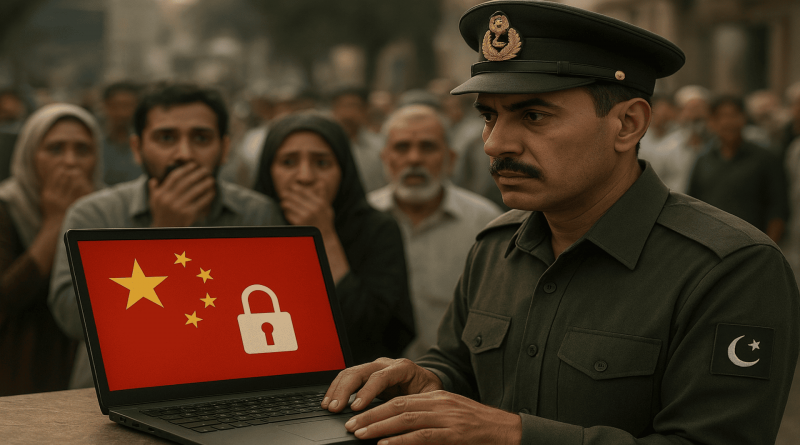ANALYSIS: How Pakistan Deploys Chinese Technology to Monitor Its Citizens
By adopting Chinese technology, Pakistan has effectively imported the architecture of one-party authoritarianism and repurposed it for its own military-led state.
In today’s interconnected world, surveillance has become the defining tool of authoritarian power. For decades, whispers of phone tapping, hidden cameras, and intercepted letters formed part of the political folklore in Pakistan. Opposition leaders complained about bugged hotel rooms, journalists spoke of mysteriously leaked recordings, and ordinary citizens lived with the suspicion that their conversations were never entirely private.
But what was once fragmented and clumsy has now been consolidated into a sophisticated and institutionalized state machinery of repression. Today, Pakistan’s rulers command a surveillance and censorship apparatus capable of monitoring millions at home. And at the heart of this system lies a troubling partnership with China, the global architect of digital authoritarianism, which has become Pakistan’s model and its main supplier.
Beijing’s Digital Spy Trade in Asia
The Pakistan-China collaboration on domestic espionage aligns with the broader framework of the Digital Silk Road, Beijing’s effort to export its technological dominance alongside its governing philosophy. As China extends its influence through infrastructure projects and military ties, it also exports the invisible infrastructure of repression.
Chinese firewalls, intercept systems, and biometric databases become complementary products. Pakistan, indebted to Chinese investment and strategically reliant on Beijing’s support, has proven to be one of the most eager markets. China is not merely exporting a surveillance technology, but an ideology of the state’s overarching control over society.
The cornerstone of this collaboration is the Web Monitoring System 2.0 (WMS 2.0), introduced in 2023. According to a recent Amnesty International report, the system is fueled by Chinese company Geedge Networks and hardware from the state-owned China Electronics Corporation. It functions like a smaller version of Beijing’s own Great Firewall, capable of deep-packet inspection, VPN detection, website blocking, and real-time throttling of online traffic.
This is not mere censorship; it is preventive digital warfare, designed to identify dissent before it can mobilize. By adopting Chinese technology, Pakistan has effectively imported the architecture of one-party authoritarianism and repurposed it for its own military-led state.
Alongside WMS, Pakistan has also integrated sophisticated European-based technology to conduct mass surveillance of personal communication devices. Pakistan’s armed forces and its notorious spy agency, the Inter-Services Intelligence (ISI), use the Lawful Intercept Management System (LIMS) to track the population’s digital activities through Pakistani telecommunications providers.
In practice, European states have legal and technical safeguards that prevent law enforcement agencies from exploiting this technology. The absence of such safeguards in Pakistan, however, empowers the government to spy on more than 4 million people at any given time. Instead of utilizing LIMS for targeted monitoring of terrorist groups within Pakistan, the state conducts indiscriminate and illegal surveillance of Pakistani citizens to suppress dissent and free speech.
Indiscriminate Surveillance over Targeted Monitoring
Pakistan’s government insists such powers are needed for national security, but the pattern of use tells a different story. The true targets are not terrorists or foreign spies; they are Pakistanis who dare to dissent. Journalists in Pakistan describe how private WhatsApp calls mysteriously leak, or how investigative reports are quietly spiked because editors fear their communications are being monitored.
Human rights defenders, particularly those campaigning against enforced disappearances, speak of constant digital harassment. Activists in Balochistan and among the Pashtun community in Khyber Pakhtunkhwa find their social media posts flagged, their movements tracked, and in some cases, their family members kidnapped by intelligence agencies.
Even judges have accused the ISI of using secret surveillance to interfere in judicial proceedings.
In each instance, surveillance serves less to protect citizens than to protect the military from accountability.
Nowhere are the costs more visible than in Balochistan, Pakistan’s most resource-rich but also the most impoverished province. Pakistan’s state breakdown on civil rights activists and the military oppression of Balochis have left the region marginalized for decades. For years, large districts of Baluchistan have been cut off from the internet entirely. These blackouts are not temporary inconveniences; they stretch on for months, even years, leaving entire communities digitally silenced.
As human rights watchdogs have documented, the blackouts often coincide with military operations, enforced disappearances, and crackdowns on protests. Families searching for missing relatives are unable to mobilize, activists cannot get their message out, and international attention is blunted by the lack of communication. In this context, WMS 2.0’s ability to block VPNs and throttle platforms is not a neutral tool but an active weapon of repression.
The Digital Silk Road Meets Rawalpindi
The Chinese role in Pakistan’s state surveillance is not merely a trade of technology, but a political partnership.
Beijing gains a strategic partner whose governance increasingly resembles its own, while Pakistan gains tools of repression that strengthen military control in areas like Balochistan and KPK, where anti-Pakistan sentiments remain strong. Pakistan’s strategic reliance on China now extends beyond roads and ports into the intimate sphere of its citizens’ communications. This alignment is ideological as it normalizes the view that dissent is treason and citizens exist to be managed, not represented.
This is why Pakistan’s surveillance state matters beyond its borders. When a fragile democracy like Pakistan adopts the Chinese model, it sends a message to other countries that repression can be imported, and authoritarian technology can be globalized. The spread of systems like WMS 2.0 is not just a Pakistani issue; it is a challenge to the very idea of digital freedom worldwide. What is tested in Balochistan today may be exported to Central Asia or other parts of the world tomorrow.
Takeaway
The track record of Pakistan’s current civil-military regime paints a bleak picture of the country’s future. It can continue down the Chinese path, perfecting the machinery of digital authoritarianism while hollowing out its democratic promises. Or it can confront the reality that surveillance without oversight is not security but tyranny.
That would mean empowering courts to enforce warrant requirements, demanding transparency from telecom companies, and refusing to import technologies designed to silence. Yet Pakistan is far from this path, given its recent trajectory on political representation and its crackdown on former Prime Minister Imran Khan.
For now, the temptation for authoritarian rule in Islamabad and Rawalpindi appears irresistible. Surveillance is cheap when subsidized by Beijing and comes in handy when backed by military power. Moreover, it is politically convenient to silence opposing voices en masse. But in choosing this path, Pakistan risks not only violating the rights of its citizens but eroding the very legitimacy it seeks to protect.
The firewall may shield those in power from criticism today, but it will also trap them in a model of governance that cannot tolerate transparency, accountability, or debate. The verdict is clear that Pakistan’s surveillance state is not merely domestic. It is the Great Firewall of China with Pakistani characteristics, assembled in Islamabad, and tested in Balochistan.


